The Great British Beer Festival (GBBF) remains a phenomenon, the biggest event of its kind. This year’s attendances were down slightly, but still around 62,500 over five days. That’s small beer, perhaps, compared to the Munich Oktoberfest’s 375,000 per day, but that event is hardly a beer festival in the way most readers of this website would understand it. Compared to Munich’s handful, there was a choice of over 1,000 beers at this year’s GBBF. And perhaps most impressive of all, this vast event is run almost entirely by volunteers — around 1,200 of them.
With various commitments in connection with my London book as well as my usual volunteering and beer sampling, this year was my longest continuous stint at the festival yet, with Tuesday, Wednesday and Thursday all spent at Earls Court. Once again working behind the Dutch-Belgian-Italian bar was fascinating and rewarding, but I also spent some time in the press room on the first floor, from where there is a panoramic view of the festival floor that really brings home the size of it all, and presented a tutored tasting in the welcome natural light of one of the multitude of hospitality suites on the same level (more about this successful occasion will appear later).
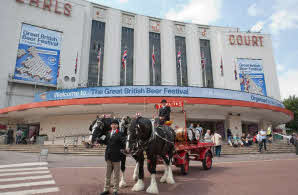
Thwaites dray outside Earls Court, possibly for that last time? Great British Beer Festival 2011. Pic: CAMRA
Much of the extensive piece I wrote here about last year’s event is still relevant as the format, scale and character were essentially the same, though the imported beer bars, Bières sans frontières, had been split up and distributed round the space, like a clique of disruptive schoolchildren forcibly scattered to different corners of a classroom. Belgians were in one block of bars, Germans and Czechs in another, Americans and others in a third. This caused some disgruntlement among volunteers, and there were dark mutterings about why it had been done, but I can see no reason to disbelieve the official explanation — that it was to improve crowd flow and to better distribute the areas where drinkers were likely to congregate.
There is a more serious issue, though, involving the BSF bars, one which I mentioned last year and which was even more pronounced this year: the gulf in variety and interest between BSF and the British bars is getting wider still. Showcasing British beer is supposed to be the raison d’être of the festival, and BSF began as a bonus extra — comparable events, such as Belgium’s Zythos Bierfestival and the Great American Beer Festival, concentrate entirely on native brews. Yes, BSF has the whole world to choose from, but the British bars should have the advantage of home turf.
This year the selection at the BSF was astounding. In partnership with the Brewers Association, the USA/Rest of the World bar was expanded to two bars side by side, one of them dedicated to US cask beers, with over 115 on offer, the biggest range yet. Another 70 international rarities were supplied in small quantities courtesy of the International Beer Challenge, alongside a much expanded range of bottles from craft breweries in Australia, New Zealand and Japan. As well as two draught unblended lambics from Cantillon and Girardin were lambics aged in spirit casks from eccentric Italian beer firm Revelation Cat, while De Molen from the Netherlands sent three big Bordeaux casks of extreme beers. The Czech offering, weak in recent years, was strengthened significantly with the inclusion of unfiltered and unpasteurised delights from several small breweries including new craft brewers Kocour and Matuška. Indeed I wouldn’t be surprised if this was the most dazzling collection of world beer ever assembled for public sale.
It has to be said: the British cask and ‘real ale in a bottle’ bars looked dowdy by comparison. This year each bar was surmounted by a banner listing the beers on sale, making it easy to run one’s eye down the long litany of low gravities, where anything a little stronger twinkled like a lonely star. Of over 400 cask choices, I counted around 32 at gravities over 5%, and three of those were from Greene King. The range of breweries represented was huge, but most with only one beer, and that one often a conservative choice. For example, Dark Star, one of the best breweries in the country in many the view of many connoisseurs, was represented only by its 3.8% Hophead and 4.2% Hylder Blond, both great beers but hardly the brewery’s most diverting products, and in the case of Hophead, already relatively widely available through the free trade.
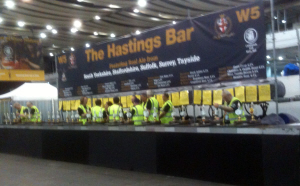
One of the cask ale bars, still under hi-vis before the public is admitted. Watch out for falling gravities! Great British Beer Festival 2011.
The results of the Champion Beer of Britain (CBoB) competition also caused some negative comment for their staidness. This year’s winner was a dark mild, for the third time in five years — Mighty Oak’s Oscar Wilde (3.7%). It’s a great beer, a fine example of its style, but its annoucement fuelled the criticism from some quarters that CBoB judges are a conservative lot who prefer weak, traditional beers. Certainly some of the other choices were less than scintillating, and veteran beer writer Roger Protz, chair of the judging panel, apparently had a hard time defending some of them at his always oversubscribed tutored tasting of the finalists. He later expressed concern about the plethora of dull golden ales laid before the judges.
Now, I fully appreciate the fact that British brewing has traditionally focused for much of the last century on low gravity session beers. I’m the first to defend the honoured place of such beers in world beer culture. The ability of British brewers to squeeze great flavour and complexity out of 3.5% quaffers can be one of the highest expressions of the brewer’s art. GBBF should certainly continue to provide a strong showcase for these styles, and I would certainly not want to see a festival dominated by geek-pleasing rare specialities and turbo strength hop bombs.
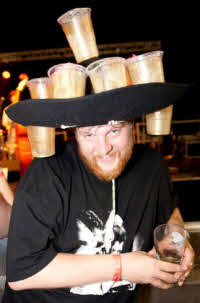
No article about a beer festival would be complete without a photograph of someone in a silly hat. Great British Beer Festival 2011. Pic: CAMRA
But brown bitters, dark milds and easygoing golden ales never did tell the whole story about British craft brewing, and that’s even more the case today, as a newly innovative and eclectic sensibility is starting to galvanise sections of the brewing and beer drinking community. Currently this may be a relatively limited and largely metropolitan phenomenon compared to the core cask session ale market, but surely it should be part of the function of an event like GBBF to highlight the latest trends within a broader picture, celebrate variety and diversity and encourage drinkers to broaden their palates, much as its transatlantic sister the Great American Beer Festival (GABF) does. There could also usefully be more space for the numerous traditional and historic British styles that don’t fit the session ale model, such as strong old ales and barley wines — and I know the National Winter Ales Festival in Manchester in January does this very well, but GBBF is the main national annual showcase and can’t afford to rely on a much smaller event to plug its gaps.
Craft lager is another obvious omission, and, as British brewers’ interest in the style grows, one that I imagine will pose the biggest challenge to GBBF traditions. The Czech and German bar was well-equipped this year with a decent air pressure system dispensing unfiltered, unpasteurised lagers well primed with natural carbon dioxide from continental-style narrow kegs and keykegs, some even served from beneath proper Bernard and Budvar bar mounts, so such beers can be dispensed effectively while sticking within CAMRA rules (On the Belgian and Dutch bar we were still struggling to serve Christoffel Blond and IJ Plzeň using hand operated air pumps which have a tendency to produce 90% of the beer as foam. On a hot day when a group of suited corporate guests has decided this is the closest available substitute for six pints of Carling, this is no fun.) Now there are a number of British brewers able to supply good quality unfiltered lagers naturally carbonated in keg, it seems absurd that the only examples on sale at the Great British Beer Festival are from the Czech Republic, Germany and the Netherlands.
I suspect the key to the disparity is in the different ways in which BSF and the British bars manage their buying. The list at BSF betrays the signs of a controlling intelligence — overall manager Andy Benson and his team of bar managers, all volunteers, use their formidable collective expertise in ordering the beers, and make it their business to keep abreast of trends and developments in international beer culture, determined to bring the best of it to London every August. This year was Andy’s last in the job, but he’s confident the bar managers will keep up the standard between them.
The beer list on the British bars, in contrast, emerges in a much more complicated fashion in which the many individual CAMRA branches play a part — recommendations from branches and local tasting panels and recognition at local festivals are key routes to consideration. I’ve no doubt that while many CAMRA branches conscientiously strive to ensure there’s a strong representation from across their area’s breweries and beer styles, others tend to pick only the personal favourites of committee members, which may well err in favour of the traditional. The various bar managers also have an input and there is some account taken of beers that win recognition from other organisations, like SIBA. Ultimately, CAMRA’s press office tell me, decisions are down to judgements about expected consumer demand. Yet there is as far as I know no systematic market research into what GBBF visitors actually do drink and want to drink, so it’s not impossible these judgements are based on unwarranted assumptions about the ‘typical’ punter.
Even the brewery bars aren’t immune. I’m sure most visitors who think about these things assume (as I did until Thornbridge put me right last year) that the brewers who rent and staff these have a free hand in deciding what beers to sell, so long as they keep within the general CAMRA guidelines (and I don’t want to dwell here on the unhelpful antics of CAMRA-baiting Scottish brewer BrewDog which a few weeks beforehand stage managed its own banning from the festival). But no, the exact beers stocked on these bars are determined by what CAMRA describes as “a negotiation process”.
It’s easy to see how this combination of beer picking by committee and estimating demand on an anecdotal basis could produce a beer list that combines illogicality and inconsistency with risk aversion and the favouring of conservative, traditional styles. It can’t be helped by the decision taken last year to reorganise the bars by alphabetical order of “counties” (or, in Scotland and Wales, arbitrary geographical groupings that don’t seem to relate to either historic counties or modern local authorities), bringing beers from all over the UK randomly together on a single bar. This doesn’t only confuse the punters, it also prevents bars developing distinct regional indentities that might contextualise styles and encourage specialist knowledge among bar staff and managers.
I suspect the response to such criticisms would be “if it ain’t broke, don’t fix it.” So long as the tens of thousands of visitors keep on coming back, there will be little appetite to stir up the hornet’s nest of local and individual sensitivites that is inevitably invested in the process. But honestly it could do with a bit of benign — and informed — dictatorship if GBBF is to remain the best possible showcase for the best of British brewing.
There was something else in the air this year too: a tinge of nostalgia, as this may well have been the last such event in the 1930s concrete bunker of Earls Court Exhibition Centre, the festival’s home for several years. Next year, the regular dates coincide with London’s hosting the Olympic Games. CAMRA has taken the brave, and I suspect ultimately the right, decision to carry on regardless, though from conversations with officers from Transport for London I judge many have underestimated the logistical challenges of navigating London during ‘Games Time’.
But Earls Court is unavailable as it’s already booked for Olympic volleyball, so GBBF is returning at least temporarily to its previous home at Olympia (ironically, as its name suggests, a former Olympic venue). After the Games, Earls Court is slated for demolition as part of redevelopment of the site and adjoining railway lands into a mixed residential, office and retail quarter, though the planning permission for this still hasn’t been granted, so no decision has yet been taken on the whereabouts of the festival in 2013. I hope the organisers ignore the well-intentioned but misguided calls to move it outside London.
Next year’s festival might be interesting for reasons other than trying to share London with the world’s biggest sports day. Partly inspired by the development of Denver Beer Week as a fringe event around GABF, the suggestion has gone out among the bloggerati for a properly coordinated GBBF fringe. To some extent this already happens — events like the White Horse’s American beer week, the annual single weekend opening of Olde Mitre and the ratebeer European meetup, and a number of smaller events in pubs and bars, already take advantage of the increased numbers of beer connoisseurs around town that week. Pulling this together into a more coherently promoted beer week for London would be a quick win, and would further bolster GBBF’s position as the mother of all beer festivals.
Beer picks
- Boon / Revelation Cat 3 year old Marsala Lambic 6% Lembeek, Vlaams-Brabant, Vlaanderen
- Broumov Opat Kvasničák Pepper 5% Broumov, Králové Hradecký kraj, Czech Republic
- Devils Backbone Barclay’s London Dark Lager 5.8% Roseland, Virginia, USA
- Fuller’s Brewer’s Reserve No 3 9% London W4, England
- Little Valley Organic Hebden’s Wheat 4.5% Hebden Bridge, West Yorkshire, England
- Molen Hot & Spicy 10.2% Bodegraven, Zuid-Holland, Netherlands



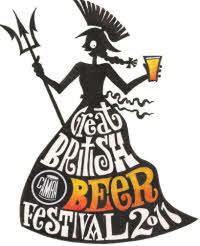
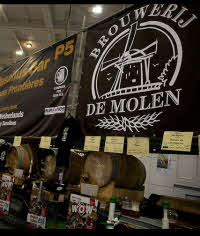



Interesting commentary. I think it highlights the problem that the organisers of the GBBF have in trying to be all things to all men and I think they generally they do a reasonable job of striking the right balance.
At one extreme you have thousands of visitors who rarely drink real ale, if at all, but are attracted by the fact that its a big national event, an evening out and an established part of the summer social circut. For them something like Dark Star Hophead will be both an entirely new experience and a “gateway” drink that perhaps encourages them to try other beers.
At the other end of the spectrum, you have the core beer geeks (and most bloggers) for whom anything near the mainstream or a sensible percentage is boring and old hat (and, far too often, to be rubbished) and for them, as you say, teh GBBF provides an unparalelled collection of rare foreign beers to swoon over.
I think there also has to be a balance of strengths towards the lower end of teh spectrum for no other reason than that you’ve got lots of people drinking lots and lots of beer (not everyone is carefully sipping their thirds whilst making tasting notes !) and what you don’t want in the present anti-alcohol climate is too much over-indulgence with its consequences and the negative publicity that would generate. In any case, even going every day I think you’d struggle not to find enough interesting beers to keep you going, who cares if you find 800 of the beers dull, you’re still not going to be able to try all the other 200.
Besides, flavourful, low alcohol beers are what Britain does best and as the festival is highlighting the best of British, I don’t see having plenty of session beers as a problem. I do worry sometimes that some in the beer blogosphere just want to turn us into a carbon copy of the US beer scene and seem to have adopted a mantra that exotic, well-hopped, high strength beers are the only ones with any value. Now I love Amercian craft beers, and taking infleunces from other countries is fine, but go too far and what you end up is a very homogenised and boring beer drinking experience, where more-or-less the same beer choice is available everywhere you go. I like the fact that different countries have different beer cultures and traditions and specialisms and I think we will make a mistake if we neglect our own just becuase we think what the neighbour over the fence has shinier and more exotic brews.
Plus, if I was a brewer, I would see GBBF as a chance to showcase my beer and introduce it to a wider audience (beyond the beer geeks and real ale enthusiasts), an excellent marketing opportunity. Looked at from that persepctive it make perfect sense to have your most popular pint on the Bar – Doom bar, Hophead, Jaipur IPA etc – as these are the ones that visitors having tasted them at the GBBF then stand a chance of seeing on the bar at their local and buying it again.
I never place much stock in the Champion beer myself as its just so incredibly subjective but have absolutely no problem with a Mild winning, why not if it was the best on the day ?
I do agree though that the layout could be improved – I think I preferred the regional set up they had before, or if you are having counties tehn at least decide whether you’re going for pre or post 1974 !
See you at olympia next year
Tom
Thanks for this thoughtful comment, Tom. I agree with lots of what you say — indeed I say myself in the original piece that there is much value in Britain’s low gravity traditional beers and I don’t at all share the dismissive attitude apparently held towards them by a number of my fellow beer connoisseurs. Yes, the beer buyers at GBBF have a difficult balance to achieve both in reflecting the range of British brewing and in satisfying the broadest variety of festival visitors, while at the same educating people about and celebrating British beer. And yes of course there should be a good few popular pints on the bars. Your point about “gateway” beers is well made, though I’d temper it slightly by pointing out that gateway beers aren’t always necessarily the most straightforward and unchallenging beers: sometimes a radical new flavour is what it takes to knock someone’s tastebuds into “getting” good beer.
But I disagree with you that they’re still getting the balance right. It’s not badly wrong, but it’s worryingly wrong, and the problem is the system doesn’t really seem to be designed to put it right.
Ideally there should be a way of sitting down with some solid facts and market research about the audience, rationally thinking through the different groups attending and what they might be looking for, setting objectives and drawing up the lists across the whole festival with all this in mind to make sure as many boxes as possible are ticked in terms of styles, regions, types of breweries, ABVs and so on. But the current system is much more haphazard than this, and I’m convinced it works against variety and adventurous choices.
I think I know what you mean when you say flavourful, low alcohol beers are what Britain does best. They’re certainly something British brewers do pretty much uniquely well. But Britain also produces some world class stronger beers, many of which draw on very long traditions — Fuller’s Gales Prize Old Ale and Vintage Ale, Theakston Old Peculier, Harvey’s Imperial Russian Stout, Traquair House Ale, Robinson’s Old Tom, Greene King Strong Suffolk, Thornbridge Bracia, Sharp’s Massive Ale to name only a few. We certainly shouldn’t disown beers like this out of fear of the neoprohibitionist nonsense that they encourage irresponsbile drinking. Beer festivals are generally good examples of how responsible drinking is possible in the right environment — the bars have a policy of refusing to sell stronger beer in pints, and in my experience the majority of festivalgoers drink in halves or less anyway, even if they have pint glasses, so they can try as many beers as possible even if they aren’t taking tasting notes on them.